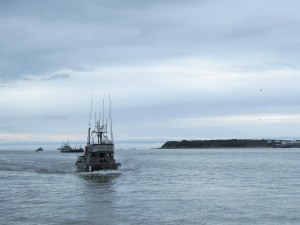
The Alaska Department of Fish and Game estimates that next summer’s sockeye run will number 46.5 million. That would leave room to harvest nearly 30 million, and would be the third above-average bay harvest in a row.
Fish and Game estimates that between 36 and 56 million sockeye will return to Bristol Bay next summer, another big year even if the total comes in at the low end.
Bristol Bay Area Research Biologist Chuck Brazil said the forecast can be broken down to an estimate for each fishing district.
“For the Naknek-Kvichak District, we’re expecting approximately 23 million fish to return. For the Egegik district, about 7.4 million. Ugashik district, 4.95 million and in the Nushagak district 10.3 million. And in Togiak, about 660,000 sockeye.”
Brazil used age, sex and length data from commercial harvests and escapement projects to make next summer’s projections.
“The piece of data that I was most excited to get was the final season harvest numbers and finalizing the age composition so we could estimate total return and compile our brood tables, and that’s the kind of information we use to model our forecasts,” he said.
This could be another summer of smaller sockeye. Brazil said the run is expected to contain a large portion of two-ocean fish. That’s based on how many one year old fish returned last summer.
“Two ocean fish are fish that mature after two years of being at sea, and those fish are typically smaller than your three ocean fish when they return,” he said.
Area Management Biologist Tim Sands put the run into a little context.
“It’s lower than last year, than the 2015 season, but it’s higher than the ten year average,” Sands said.
On the heels of two strong seasons, another large run could be hard to sell, said drift fisherman Abe Williams, who is the president of Bristol Bay Regional Seafood Development Association.
“I think it means more challenges, how we get rid the current inventory that we have and prepare for the abundance of salmon that’s coming in 2016,” he said.
But the forecast is just that: a potential return. This summer, the run was about 17 percent larger than the forecast. In 2014, it was about 53 percent above forecast. And the size of the 2016 run won’t be known until the end of next summer.
The University of Washington’s Fisheries Research Institute is taking its own stab at a forecast. That’s likely to come out next week.




